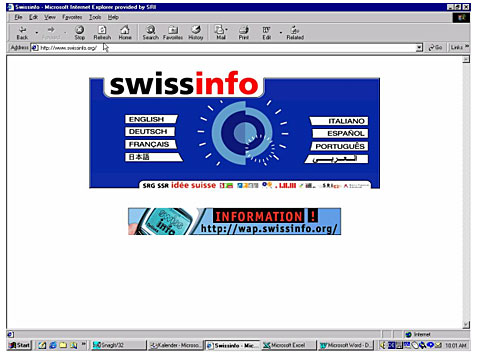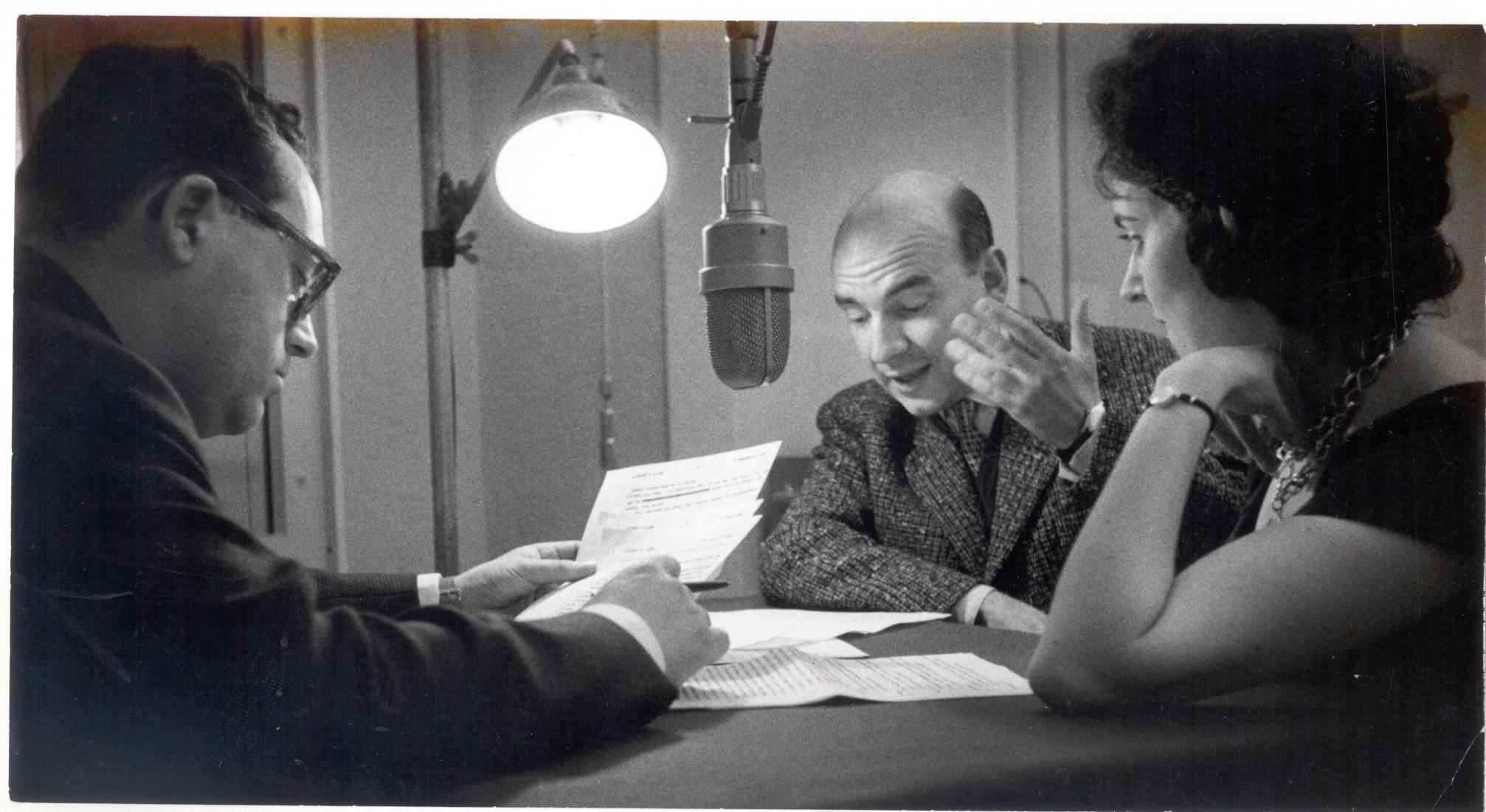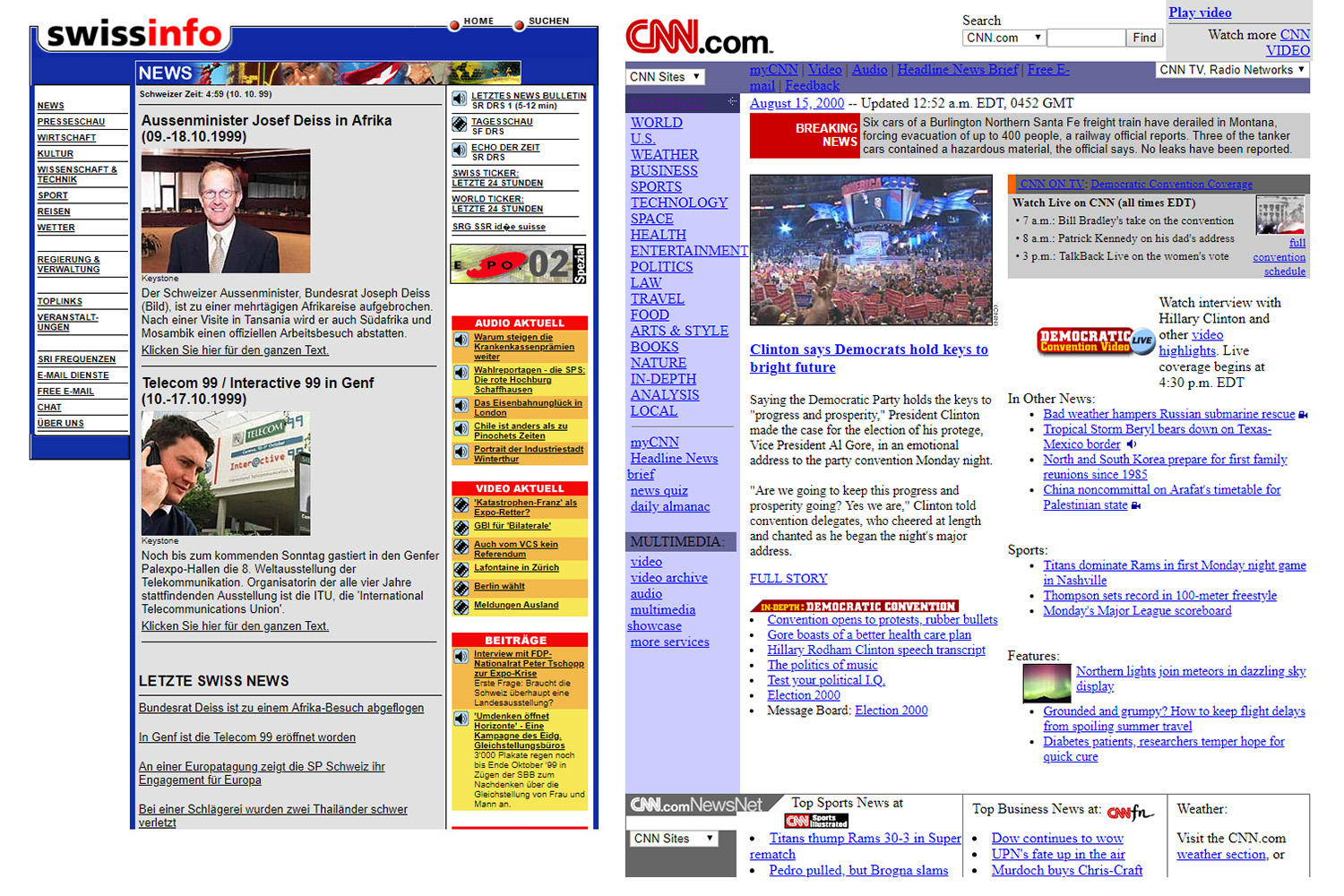The day Switzerland found its online voice

SWI swissinfo.ch is 20 years old today. It still fulfills the same mission as its former avatar Swiss Radio International (SRI) but by means that barely existed two decades ago.
Imagine a time when there were no smartphones or tablets. Where the personal computer was too expensive for mass ownership. A time when there was no Facebook, Twitter or Instagram. Only the brave dared “chat” on Yahoo’s forums. Google had just made the transition from a garage project to a company.
Internet connections were still very slow and very expensive. You paid by the minute, once the modem deigned to connect to the web, often after several attempts, punctuated by the famous electronic gurgling sound of two computers getting to know each other. It was not uncommon to wait a minute to see a simple picture displayed on the screen. And video? They were some available but you had to be very, very patient. Broadband became widespread only in the year 2000 and YouTube arrived five years later.
At the beginning of 1999, 34% of Swiss people (but only 4% across the globe) were connected to the internet. This was already ten times more than in 1995. Despite its imperfections and teething problems, the web was taking off. And nothing could stop it.
The glory days of radio
At the same time, SRI was looking for a way forward. Switzerland’s voice in the world already had a long and glorious history. Since 1935, the Swiss Short Wave Service (SRI) had been broadcasting national radio programmes for Swiss citizens scattered throughout the world. The Second World War accelerated things. Shortwave broadcasting was also available in English, Spanish and Portuguese. The news service was appreciated for its neutrality.

In 1954, the federal government recognised the Swiss Short Wave Service’s contribution to connecting the country with its expatriates and as “Switzerland’s influence on the world”. But it would take another ten years for officials to agree to subsidise this international radio service. In 1978, it officially became SRI. The content became more comprehensive – 70 hours of programming every day, in seven languages – making it one of the most popular radio stations in the world, after American, British, French and German broadcasters. The station’s headquarters in the Swiss capital Bern received nearly 1,000 letters every month from enthusiastic, critical and curious listeners.

More
From analogue to digital
Ahead of its time
Two decades later, the radio station was still popular, but the landscape had changed significantly. With the fall of communism, it lost its mantle as “the voice of the free world” for people living under communist dictatorships. The huge short-wave transmitters had given way to satellites, which were much cheaper. The government – which then financed half of SRI’s budget – wanted to save even more money. There were plans to launch into television, but the idea was quickly withdrawn due to the cost it entailed. Instead, a decision was made to invest in a growing technology: the internet. Technicians began putting together the skeleton of the new website (swissinfo.org in those days).
“Financially, they [SRI] were under enormous pressure, especially from Armin Walpen, then director general of the Swiss Broadcasting Corporation, but also from the political world,” recalls former journalist Beat Witschi. “I think that consciously or unconsciously, Nicolas Lombard [SRI director at the time] was ahead of his time. He knew the radio was going to die.”
He may have known it, but he didn’t say it aloud. In 1999, swissinfo.org was presented as an extension of SRI. The radio service was gradually reduced, until its last broadcast in October 2004.
SRI already had some experience of the internet. In 1995, the station had a fledgling web page – which only displayed the programmes and a list of frequencies. Three years later, those with a good internet connection could even listen to radio online, first in English and Portuguese.
And then there’s the video. Since 1987, SRI journalists were delivering short stories of a few minutes in English on Switzerland for “CNN world reports”. From 1991 onwards, reports bearing the “Swiss World” logo could be seen on around 30 TV channels around the world.
A real information website
The launch of swissinfo.org on March 12, 1999 showcased a new site with text, images and sound, (video would soon follow). It also offered useful links, a free email service, a chat platform, forums, and of course the one thing nobody could do without: information on the weather.
“People were asking me if the internet was really going to last, if it wasn’t just a fashion,” recalls Witschi. “On the one hand, I thought the question was silly, but on the other, I could understand why it needed be asked. What we were doing was so alien in a way. I was returning from the United States and I felt a little jetlagged, because everything there had happened faster.”

swissinfo.ch was part of the first wave of information sites in Switzerland. A few months before the year 2000, Swiss papers acquired a web presence. However, they were rather rudimentary sites that only presented brief news and a few articles from their paper editions. Radios and television stations were also present in the online space but mainly used it to promote their programmes on air or on cable.
What is a CMS?
swissinfo.ch could not showcase its multimedia and multilingual output at the time on its web page. The technology only allowed the use of blocks of text without the possibility of formatting anything. It needed a real CMS (content management system). Two years before the first readymade CMS reached the market, swissinfo.ch specialists developed its in-house version called Xobix.
When working for CNN in the US, Witschi was impressed by their CMS which was better than anything else in Europe at the time: “I showed it to the swissinfo.ch team and asked them to make the same thing. And they did.”

In fact, they did even better. Xobix was also able to handle multiple languages, including Arabic, whose right-to-left writing is not an easy task for a programmer.
“Our developers have always been very good. The tool they designed then, no one else had it,” remembers Witschi.
It was so avant-garde that swissinfo.ch became the Swiss Broadcasting Corporation’s web competence centre for several years, hosting the servers of all public radio and television sites in the in the building’s cellar.
And the story continues…
* The article was edited on March 13 with regard to information on the development of the Xobix content management system.

More
Behind the scenes with our online media team
Translated from French by Anand Chandrasekhar

In compliance with the JTI standards
More: SWI swissinfo.ch certified by the Journalism Trust Initiative













You can find an overview of ongoing debates with our journalists here . Please join us!
If you want to start a conversation about a topic raised in this article or want to report factual errors, email us at english@swissinfo.ch.